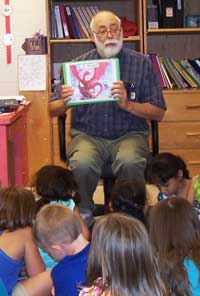|
Grandpa Reads



February 2018
I really hate television. I don't like videos much either. So it's not without trepidation that I post these videos of me reading to young children.
I'd much rather read directly to children than through a video camera as an intermediary. So much seems to be lost in the process of video recording and re-playing. I think the interaction between the teller and the listener is at least as important as the content, and probably more so.
Nevertheless, here they are. My advice to parents, grandparents, teachers and other care-givers. Watch the videos yourselves. If you like them, get the book and tell the story to your children yourselves, in your own way.
Actually I don't read stories. I tell them. Television seems to have rendered story-telling a lost art. That is sad.
I usually stick fairly closely to the story line; but not always. The images in the books, I use for props. The images are important. If I had artistic talent, I'd draw my own images; but since I don't, I use the images that come with the book.
Here's what's posted so far. I intend to add more later.
“Wilky the White House Cockroach” by Howie Schneider: The story of how Wilky hitches a ride to the White House in a pizza box and befriends the President; and how the President learns that even with cockroaches, diplomacy trumps war.
“The Lorax” by Dr. Seuss: Along with the game, “Plant a Tree for the Lorax”, which is a variation on pin the tail on the donkey.
“Baby Rattlesnake” by Te Ata, Lynn Moroney and Mira Reisberg: Baby Rattlesnake wants a rattle so bad he cried for a new rattle all day and night; but his new rattle only got him into trouble.
“The Two Stubborn Zax” by Dr. Seuss: The two Zax are heading in opposite directions; but neither will move out of the other's way.
“My Many Colored Days” by Dr. Seuss, with Steve Johnson and Lou Fancher: “You'd be surprised how many ways I change on different colored days.”
“The Gruffalo” by Julia Donaldson and Axel Scheffler: Little mouse thinks there is no such thing as a gruffalo — until he meets one.
“King Louis Katz” by Dr. Seuss: All the Katz are holding up each other's tail; but what happens to the last cat in the line?
“One Fish Two Fish Red Fish Blue Fish” by Dr. Seuss: Best book in the English language to learn rhyming.
“Sparrow Girl” by Sara Pennypacker and Yoko Tanaka Ming Li saves seven sparrows during China's "War on the Sparrows."
“Rainbow Crow” by Nancy Van Laan and Beatriz Vidal How Rainbow Crow brings fire to the Earth and melts the snow.
“Nine in One Grr! Grr!” by Blia Xiong, Cathy Spagnoli and Nancy Hom Black bird saves the world from being overrun by tigers.
“And Me Coyote” by Betty Baker and Maria Horvath How Coyote helped make the world.
“The Tidy King” in Moon Stories by William Wiesner Iranian folk tale of a king who tried to clean the Moon.
“Eyes of the Dragon” by Margaret Leaf and Ed Young The Mayor builds a wall around the village and hires a famous dragon painter to paint a dragon on the wall. The dragon comes to life and flies away as the wall crumbles to rubble.
“The Funny Little Woman” by Arlene Mosel and Blaire Lent The Funny Little Woman who loved to laugh and make rice dumplings becomes the richest woman in Japan.
“Earth Mother” by Ellen Jackson and Leo and Diane Dillon Earth Mother visits the four corners of her world. A wonderful book to read on Earthday.
“A Chocolate Moose for Dinner” by Fred Gwynne A book full of adorable puns.
Creature Poetry 1:
a) The Cockroach
b) The Elephant, by Hillaire Belloc
c) The Germ
d) The Giraffe, author unknown
e) The Medusa, adapted from the poem by Paul Perro
f) The Shark, by Kenn Nesbitt
Creature Poetry 2:
a) The Fennec Fox
b) The Hippopotamus
c) The Shark, by Kenn Nesbitt
d) The Ostrich, by Mary E. Wilkins Freeman
e) The Piranha, by Dick King-Smith
f) The Medusa, adapted from the poem by Paul Perro
g) The Rhinoceros
Creature Poetry 3:
a) The Platypus, adapted from the poem by Mr. R.
b) The Crocodile, by R. E. Slater
c) The Gnat, adapted from the poem by Rosemary Goodnight
d) The Bat, from the St. Louis Zoo
e) The Vampire Bat
Creature Poetry 4:
a) The Dragon by Jack Prelutsky
b) The Iguanadon by Jack Prelutsky
c) The Leprechaun, adapted from Little Land by Malvina Reynolds
d) The Gazelle by Giles Andreae
e) The Hummingbird
f) The Jaguar, adapted from a poem by Andres Eduardo Torres
g) The Kangaroo
Creature Poetry 5:
a) The Medusa, adapted from the poem by Paul Perro
b) The Quetzalcoatlus adapted from a poem by Jack Prelutsky
c) The Seahorse by Douglas Florian
d) The Snake by Giles Andreae
e) The Tasmanian Devil
f) The Tiger by William Blake
g) The Tyrannosaurus Rex by Jack Prelutsky
h) The Unicorn by Shel Silverstein
i) The Yak by Hillaire Belloc
j) The Zebra by Giles Andreae
Creature Poetry 6:
a) The Tyrannosaurus Rex by Jack Prelutsky
b) The Crocodile, by R. E. Slater
c) Thge Dragon by Jack Prelutsky
d) Monster Mothers by Florence Parry Heide
e) The Ogre adapted from a poem by Rosemary Goodnight
f) The Leprechaun, adapted from "Little Land" by Malvina Reynolds
Mostly Bird Poetry:
a) The Roadrunner
b) The Leprechaun, adapted from "Little Land" by Malvina Reynolds
c) The Ostrich, by Mary E. Wilkins Freeman
d) The Vampire Bat
e) The Eagle
f) The Owl, author unknown
“The Owl”, poem, author unknown:
“The Sea Star”, poem by Douglas Florian:
Sharks 1: Selected pages from "Sharks and other Creatures of the Deep," edited by Susan Barraclough:
###
|